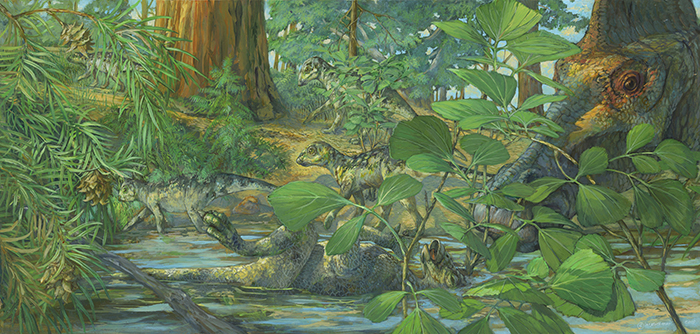| Location: Home > News > Events |
| Xinhua:Scientists find possible evidence of chromosomes, DNA preserved in dinosaur fossils |
|
Cartilage cells from skull of Hypacrosaurus nestlings. On the left are two cells at the end of cell division, showing material consistent with condensed nuclei. Right in the middle is the higher magnification of another cell that shows chromosomes. On the right is an isolated dinosaur cartilage cell reacting with the DNA stain propidium iodide (red dot, inside the cell). (Photos provided to Xinhua by Alida Bailleul and Zheng Wenxia) Although the ancient DNA could not be used to bring dinosaurs back to life, scientists believe they could use the DNA to trace the evolution of life. BEIJING, March 2 (Xinhua) -- An international team has found possible evidence of fossilized cell nuclei and chromosomes within preserved cartilage of baby duck-billed dinosaurs dating back 75 million years. The research was conducted by a team led by Alida Bailleul, of the Institute of Vertebrate Paleontology and Paleoanthropology of the Chinese Academy of Sciences (CAS), and Mary Schweitzer, of North Carolina State University in the United States. The dinosaur belongs to the genus Hypacrosaurus, and comes from a nesting ground in Late Cretaceous sediments, discovered in 1988 by paleontologist Jack Horner, in northwest Montana in the United States. Bailleul conducted microscopic analyses of skull fragments from these nestling dinosaurs. In one fragment, she noticed some exquisitely preserved cells within calcified cartilage on the edges of a bone. Two cartilage cells were still linked together by an intercellular bridge, morphologically consistent with the end of cell division. Internally, dark material resembling a cell nucleus was also visible. One cartilage cell preserved dark elongated structures morphologically consistent with chromosomes. "I couldn't believe it - my heart almost stopped beating," said Bailleul. Bailleul and Schweitzer, together with Zheng Wenxia from North Carolina State University, sought to determine whether original molecules were also preserved in the dinosaur cartilage. The team performed immunological and histochemical analyses on the skull of another nestling Hypacrosaurus from the same nesting ground. The immunological test supports the presence of remnants of original cartilaginous proteins in this dinosaur. The researchers also isolated individual Hypacrosaurus cartilage cells and applied two DNA stains, DAPI and PI. These bind specifically to DNA fragments in extant material, and some of the isolated dinosaur cells showed internal, positive binding in the same pattern seen in modern cells, suggesting some original dinosaur DNA may be preserved.
Reconstruction of the nesting ground of Hypacrosaurus (Photo provided to Xinhua by Michael Rothman) "These new, exciting results add to growing evidence that cells and some of their biomolecules can persist for a long time. They suggest DNA can be preserved for tens of millions of years, and we hope this study will encourage scientists working on ancient DNA to push current limits and use new methodology in order to reveal all the unknown molecular secrets that ancient tissues have," said Bailleul. The possibility that DNA can survive for tens of millions of years is not currently recognized by the scientific community. It is generally accepted that DNA persists less than 1 million years. These new data suggest that DNA, in some form, might persist in Mesozoic tissues, and lay the foundation for future efforts to recover and sequence DNA from other very ancient fossils, said the researchers. But this is not Jurassic Park science, said Bailleul. "Here we have probably fossilized remnants, very minute amounts of fossilized dinosaur DNA, but that is a hypothesis at this stage. And the original dinosaur DNA might be transformed chemically during fossilization," she said. "No one really understands what happens to DNA in material so old, but our study encourages more research in ancient DNA to understand the processes of DNA fossilization," said Bailleul. "Our data suggest some DNA may still be preserved in these dinosaur cells, but it will never be possible to recreate a dinosaur. Once a species goes extinct, it's extinct forever," she added. Although the ancient DNA could not be used to bring dinosaurs back to life, scientists believe they could use the DNA to trace the evolution of life. The findings of the research team were recently published in National Science Review. link: https://academic.oup.com/nsr/advance-article/doi/10.1093/nsr/nwz206/5762999 |

